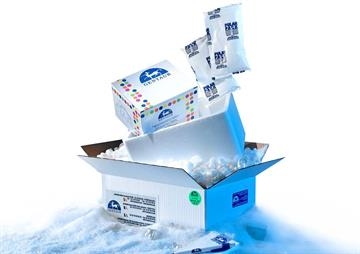ANXA1 Chemi-Luminescent ELISA Kit (Human) (OKCD03297)

ANXA1 Chemi-Luminescent ELISA Kit (Human) (OKCD03297)
1935.4 EUR
In Stock
quantity
Produktdetaljer
Katalognummer: 247 - OKCD03297
Produktkategori: Företag och industri > Vetenskap och laboratorium
Aviva Systems BiologyGentaur
Storlek: 96 Wells
Related Products
OKCD03297
ANXA1 Chemi-Luminescent ELISA Kit (Human) (OKCD03297)
Description of target: Plays important roles in the innate immune response as effector of glucocorticoid-mediated responses and regulator of the inflammatory process. Has anti-inflammatory activity . Plays a role in glucocorticoid-mediated down-regulation of the early phase of the inflammatory response . Promotes resolution of inflammation and wound healing . Functions at least in part by activating the formyl peptide receptors and downstream signaling cascades . Promotes chemotaxis of granulocytes and monocytes via activation of the formyl peptide receptors . Contributes to the adaptive immune response by enhancing signaling cascades that are triggered by T-cell activation, regulates differentiation and proliferation of activated T-cells . Promotes the differentiation of T-cells into Th1 cells and negatively regulates differentiation into Th2 cells . Has no effect on unstimulated T cells . Promotes rearrangement of the actin cytoskeleton, cell polarization and cell migration . Negatively regulates hormone exocytosis via activation of the formyl peptide receptors and reorganization of the actin cytoskeleton . Has high affinity for Ca2+ and can bind up to eight Ca2+ ions . Displays Ca2+-dependent binding to phospholipid membranes . Plays a role in the formation of phagocytic cups and phagosomes. Plays a role in phagocytosis by mediating the Ca2+-dependent interaction between phagosomes and the actin cytoskeleton .;Species reactivity: Human;Application: ;Assay info: Assay Methodology: Quantitative Sandwich ELISA;Sensitivity: 3.12 ng/mL
1935.4 €
OKCD03914
KIT Chemi-Luminescent ELISA Kit (Human) (OKCD03914)
Description of target: Tyrosine-protein kinase that acts as cell-surface receptor for the cytokine KITLG/SCF and plays an essential role in the regulation of cell survival and proliferation, hematopoiesis, stem cell maintenance, gametogenesis, mast cell development, migration and function, and in melanogenesis. In response to KITLG/SCF binding, KIT can activate several signaling pathways. Phosphorylates PIK3R1, PLCG1, SH2B2/APS and CBL. Activates the AKT1 signaling pathway by phosphorylation of PIK3R1, the regulatory subunit of phosphatidylinositol 3-kinase. Activated KIT also transmits signals via GRB2 and activation of RAS, RAF1 and the MAP kinases MAPK1/ERK2 and/or MAPK3/ERK1. Promotes activation of STAT family members STAT1, STAT3, STAT5A and STAT5B. Activation of PLCG1 leads to the production of the cellular signaling molecules diacylglycerol and inositol 1,4,5-trisphosphate. KIT signaling is modulated by protein phosphatases, and by rapid internalization and degradation of the receptor. Activated KIT promotes phosphorylation of the protein phosphatases PTPN6/SHP-1 and PTPRU, and of the transcription factors STAT1, STAT3, STAT5A and STAT5B. Promotes phosphorylation of PIK3R1, CBL, CRK (isoform Crk-II), LYN, MAPK1/ERK2 and/or MAPK3/ERK1, PLCG1, SRC and SHC1.1;Species reactivity: Human;Application: ;Assay info: Assay Methodology: Quantitative Sandwich ELISA;Sensitivity: 0.0412 ng/mL
1935.4 €
OKCD03379
CLCF1 Chemi-Luminescent ELISA Kit (Human) (OKCD03379)
Description of target: Cytokine with B-cell stimulating capability. Binds to and activates the ILST/gp130 receptor.;Species reactivity: Human;Application: ;Assay info: Assay Methodology: Quantitative Sandwich ELISA;Sensitivity: 5.5 pg/mL
1935.4 €
OKCD03382
CNTF Chemi-Luminescent ELISA Kit (Human) (OKCD03382)
Description of target: CNTF is a survival factor for various neuronal cell types. Seems to prevent the degeneration of motor axons after axotomy. ;Species reactivity: Human;Application: ;Assay info: Assay Methodology: Quantitative Sandwich ELISA;Sensitivity: 62.5 pg/mL
1935.4 €
OKCD03385
CNTN1 Chemi-Luminescent ELISA Kit (Human) (OKCD03385)
Description of target: Contactins mediate cell surface interactions during nervous system development. Involved in the formation of paranodal axo-glial junctions in myelinated peripheral nerves and in the signaling between axons and myelinating glial cells via its association with CNTNAP1. Participates in oligodendrocytes generation by acting as a ligand of NOTCH1. Its association with NOTCH1 promotes NOTCH1 activation through the released notch intracellular domain (NICD) and subsequent translocation to the nucleus. Interaction with TNR induces a repulsion of neurons and an inhibition of neurite outgrowth .;Species reactivity: Human;Application: ;Assay info: Assay Methodology: Quantitative Sandwich ELISA;Sensitivity: 0.156 ng/mL









